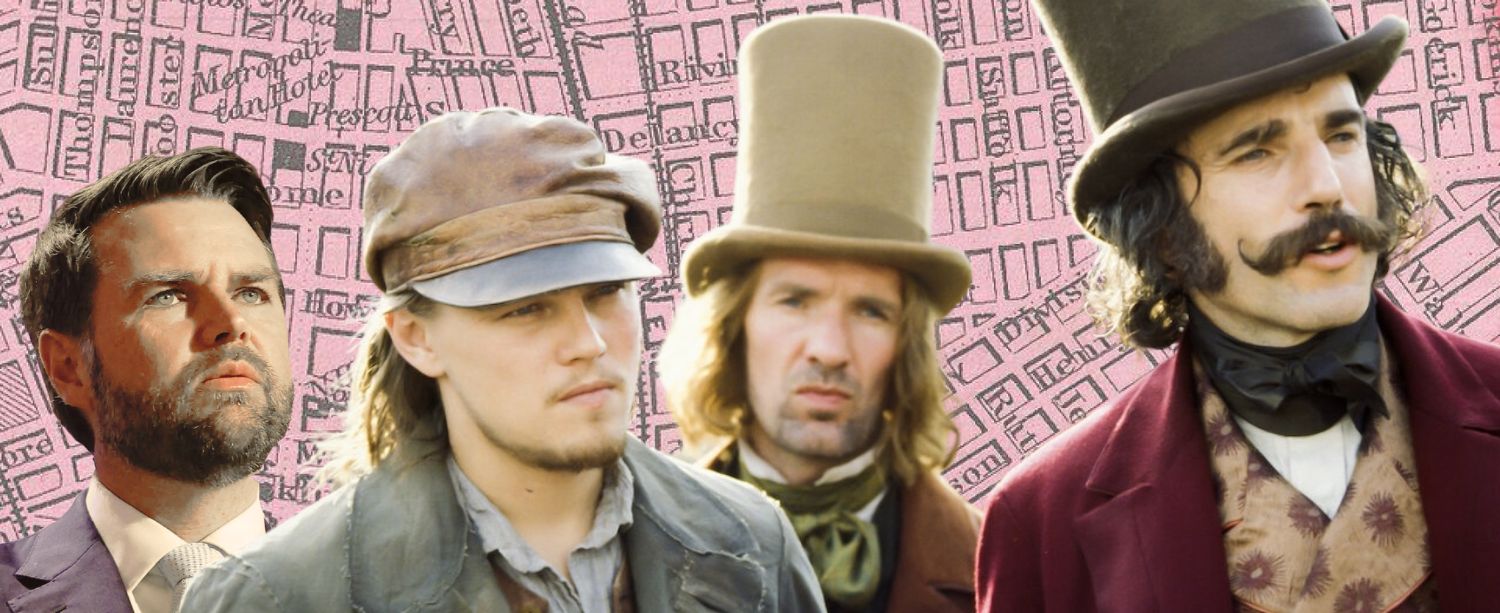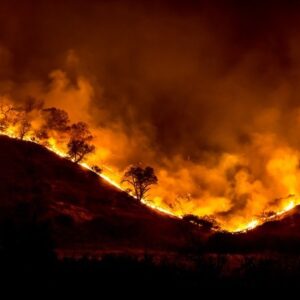
Rebecca Solnit: JD Vance is Just Another Know Nothing Nativist
“Vance seems to assume that large numbers of native-born white people don't constitute ethnic enclaves.”
For a person who’s supposed to be smart, Republican vice-presidential candidate JD Vance delivers a pretty high volume of stupid and unstrategic remarks. It’s hard to tell if he is just used to operating within whatever tech-oligarchy or MAGA insider circles where this stuff flies, whether he just doesn’t have a clue, or if there isn’t really much difference between the two conditions.
His latest misstep, surprisingly, doesn’t have to do with women and how they should not have rights, but with poor recall of a movie he thought buttressed his anti-immigration argument. Plot spoiler: it didn’t.
A few days ago, Vance was questioned about some remarks he’d made to a far-right podcaster:
You had this massive wave of Italian, Irish, and German immigration right? And that had its problems, its consequences. You had higher crime rates, you had these ethnic enclaves, you had inter-ethnic conflict in the country where you really hadn’t had that before.
Asked about this a few days ago, he skipped the chance to save his bacon and doubled down (just like he did when it came to childless cat ladies) declaring: “Has anyone ever seen the movie Gangs of New York? That’s what I’m talking about. You know, when you have these massive ethnic enclaves forming in the country, it can sometimes lead to higher crime rates.”
Film criticism isn’t really a job requirement for a vice president, but basic mastery of facts should be—or to lower the bar really far, not saying super-stupid shit. Martin Scorsese’s 2002 film Gangs of New York is about the rivalry between the immigrant Irish Catholics in the slums of 1850s Manhattan and their enemies, the Bowery Boys, who in some iterations were a gang tied to the anti-immigration Know Nothing Party. The violence at the heart of the movie is occasioned by an ethnic enclave of older white immigrants who are hostile to newcomers, specifically to Irish Catholics. The villain of the movie is gang leader Bill the Butcher, played with oily hair and campy menace by Daniel Day Lewis. The Irish fight back, but their violence seems generated by this malevolent hostility.
Gangs of New York is loosely drawn from Herbert Asbury’s lurid 1928 history of the New York underworld before the Civil War. Scorsese’s Bill the Butcher is based on the New Jersey-born butcher, gang leader, and brawler William Poole (most of the other characters in the film are fictional). Here’s a bit of what Poole was like, as reported in the New York Daily Herald in 1846: “William Poole and Smith Ackerman were amusing themselves by putting two dogs to fight in Christopher Street, creating a most disgraceful riot.” When someone tried to stop the fight, Ackerman “knocked him down and nearly gouged out his left eye,” and he and Poole were arrested.
Vance seems to assume that large numbers of native-born white people don’t constitute ethnic enclaves, and that communities of immigrants somehow do.
But a lot of his violence wasn’t just recreational; he was a nativist “shoulder hitter” intimidating voters at the polls and later running a saloon in which Catholics—”anyone who didn’t eat meat on Friday”—were unwelcome. In 1855, in a brawl with the noted pugilist Tipperary-born John Morrissey, he was fatally wounded and on his deathbed, reported the New York Times, he declared “I think I am a goner. If I die, I die a true American, and what grieves me most is, thinking that I’ve been murdered by a set of Irish—by Morrissey in particular.”
His funeral was a huge affair, pious Protestant sermons were delivered, an estimated 50,000 swarmed the Brooklyn docks awaiting the unloading of his coffin from the ferry and the procession on its way to Greenwood Cemetery. “He was in an excellent stage of preservation, only slight indications of decomposition being visible on his forehead,” reported the New York Herald, also noting “the whole makeup of the procession proved that a strong national feeling was at the bottom of the whole proceeding,” a dainty euphemism for the anti-immigrant politics that gave rise to the violence that killed him. “This is proved by the great turnout of the Americans and Know Nothings.”
The Bill the Butcher version of the Bowery Boys were to the Know Nothings more or less what the Boogaloo Bois are to MAGA, a loosely affiliated but ideologically aligned group of thugs eager to inflict violence on the enemy. The Know Nothing Party arose in the 1840s as a political organization whose name came from members’ denial that they knew anything about it. Smithsonian Magazine describes it in startlingly familiar terms:
At its height in the 1850s, the Know Nothing party, originally called the American Party, included more than 100 elected congressmen, eight governors, a controlling share of half-a-dozen state legislatures from Massachusetts to California, and thousands of local politicians. Party members supported deportation of foreign beggars and criminals; a 21-year naturalization period for immigrants; mandatory Bible reading in schools; and the elimination of all Catholics from public office.
One major thread of American history is the centuries of racial and religious intolerance that manifested as violence, from the Puritans and conquistadors and their successors committing genocide to snatch this continent from its original inhabitants through the enslavement of Black people and their continued oppression and through waves of anti-immigrant hatred by whites who were themselves earlier settlers but considered themselves native and the newcomers intruders.
As in Scorsese’s blood-soaked movie, the white people who think this country is only for people exactly like them have been the great source of violence and conflict all along.
In days of yore, the hatred manifested as riots and massacres from New Orleans (where eleven Italians were lynched in 1891) to Tulsa to Detroit (where the 1960s riot by Black people is widely known, the several earlier anti-Black riots by white people largely forgotten) to San Francisco’s anti-Chinese riots of the 1870s. More decorous versions simply excluded Jews, Blacks, and others to create those ethnic enclaves Vance decries in the form of elite institutions from country clubs to, formerly, Congress and the courts.
More recently intolerance has manifested as mass shootings by white supremacists, from the massacre of 11 Jews in a Pittsburgh synagogue in 2018 to the mowing down of 23 Latinx people in El Paso in 2019 (“El Paso Shooting Suspect’s Manifesto Echoes Trump’s Language” said the New York Times‘s headline) to the murder of ten people, eight of them Black, in a Buffalo supermarket in 2022. In October of 2019, Vance’s running mate, Donald Trump, suggested shooting immigrants in the leg and, cartoonishly, digging a border moat to be filled with snakes or alligators; in the latter’s current campaign he proposes roundups, camps, and mass deportations, a xenophobic threat that has received remarkably little attention.
Vance himself ran an anti-immigrant ad earlier this year that announced “Biden’s open border is killing Ohioans with more illegal drugs and more Democrat voters pouring into this country.” While it’s true that people tend to vote for those who don’t demonize them, Vance seems to be tapping into the MAGA claim that hordes of non-citizens are voting, a justification for stripping voting rights from legitimate voters, particularly the young, poor, and nonwhite.
An underlying justification for the Trump-instigated January 6, 2021 attack on The Capitol and the 2020 election outcome, was a sense that if Biden did get more votes, those votes were illegitimate because only white people should count or maybe count more. (Similarly Vance has argued that childless people shouldn’t vote, and that maybe parents should get more votes for having more kids, an arrangement that he seems unlikely to desire for BIPOC voters. His obsession with reproduction seems to be driven by Great Replacement fears that the white population is declining.) That fear of difference curdled into hate is routinely deployed by the right.
Vance’s wife’s parents and his tech-oligarch patrons are immigrants, the former from India, the latter, in the case of David Sacks, from South Africa (like Elon Musk), while Peter Thiel was born in Germany. But consistency is not really something Vance, who once heartily denounced Trump, has pursued (and Trump’s own first and third wives, as has often been noted, are immigrants).
In the run-up to the 2016 election I wrote for Lit Hub that Donald Trump should visit New York, where all the terrible things he railed about were actually working out very well, telling him:
You rail against immigrants, but more than a third of New York City residents are immigrants—37 percent. About 500,000 residents are undocumented, and they are some of the hardest workers making this city go. If you drove them out, the restaurant and hotel industries would collapse into crisis. Unlike you, 75 percent of undocumented New York City residents pay taxes, according to former mayor Michael Bloomberg, who also points out the low crime rate among that population. Overall, whether they’re janitors or doctors, immigrants energize and enrich this city. You should check out Queens, the borough in which you were raised. It is now the most linguistically diverse place on earth. It’s the part of the city where most of the 800 languages to be found here are spoken.
But the New York of the 1980s had notable white-on-Black crime incidents, including the 1989 murder of Yusef Hawkins by a gang of Italian Americans in Brooklyn’s Bensonhurst neighborhood who had been waiting in ambush, and Trinidadian Michael Griffith, who was hit by a car trying to escape a beating from a white mob in Queens’s Howard Beach in 1986. A film Vance is unlikely to mention is Spike Lee’s 1989 Do the Right Thing, about this kind of conflict generated by white racism and specifically inspired by the gang attack on Griffith and his friends. New York City nowadays is not without trouble, but the ethnic-white enclaves generating this racist violence seem to have dispersed.
Vance seems to assume that large numbers of native-born white people don’t constitute ethnic enclaves, and that communities of immigrants somehow do (and he’s clearly uninterested in understanding the forces, positive and negative, that often make newcomers cluster). MAGA has been a largely white movement of non-urban people who seem to think, like Trump himself, that people unlike them are scary and that there is only safety in homogeneity. So if you bend it around and maybe turn it inside out, there’s some “she made him do it” logic to Vance’s declaration “What happens when you have massive amounts of illegal immigration? It actually starts to create ethnic conflict. It creates higher crime rates.” It’s just that the conflict and crime doesn’t come from the immigrants.
As in Scorsese’s blood-soaked movie, the white people who think this country is only for people exactly like them have been the great source of violence and conflict all along, and more of the same is basically the platform Vance and Trump are running on. They’re a problem for which, happily, we have a really good solution.
Rebecca Solnit
Writer, historian, and activist Rebecca Solnit is the author of more than twenty-five books on feminism, western and urban history, popular power, social change and insurrection, wandering and walking, hope and catastrophe. Her books include this year’s No Straight Road Takes You There, as well as Orwell's Roses, Recollections of My Nonexistence; Hope in the Dark; Men Explain Things to Me; and A Paradise Built in Hell: The Extraordinary Communities that Arise in Disaster. A product of the California public education system from kindergarten to graduate school, she writes regularly for the Guardian and serves on the boards of the climate groups Oil Change International and Third Act.












